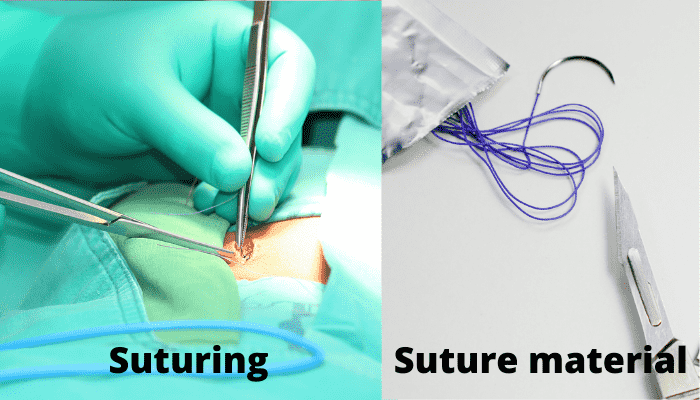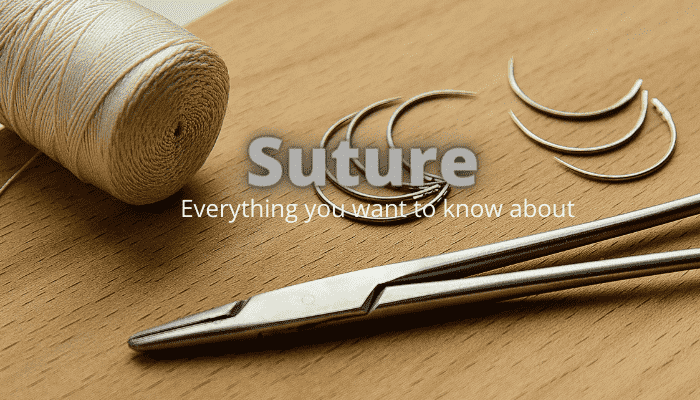Suture
Origin: 1535–45; Suture word came from Latin word – sūtūra means a sewn seam, equivalent to sūt(us) (past participle of suere means to sew / stitch / tack together) + -ūra-ure
What does Suture mean / What is Suture?
Suture word has different meanings –
In surgery suture word is used either to define a suture pattern or surgical suture material. The term suture when used as a noun means a material used to close the wound and as a verb, the pattern or technique of suturing.
Noun – If it is used as a noun then this term defines a material (thread/cord/strand/pin) / medical devices used to close the different types of wounds, ligate the blood vessels etc (See Uses) during an injury or surgery. Or a particular method of doing this. And sometimes it is also referred to one of the stitches or row of stitches holding the edges of a wound or surgical incision together. Sutures may be absorbable or non-absorbable.
Verb – As a verb suture words means pattern or technique of suturing. e.g. purse string suture, horizontal mattress suture.
Suturing means process of stitching up (a wound or incision) with a suture material. Suturing of a wound is done by using a sterile needle and thread. Sutures or stitches are secured with different types of surgical knots like surgeon’s knot, granny’s knot etc. It is important to learn and master suturing techniques.
Ligature – It is a thread or cord used to tie a vein or artery to control bleeding.

Use of sutures:
- To bring the edges of a wound in close / proper approximation
- To ligate blood vessels like artery or vein to control haemorrahge
- To close wounds to reduce wound infection
- To reduce dead space in order to reduce chances of fluid accumulation and suture dehiscence
- To support and strengthen wound edges until healing
- To reduce scaring
- To reduce skin tension and dehiscence of healing wound edges
- To hold drains / implants / organs in position/place
- To provide mechanical support
- To close any accidental opening/ reduce the size of natural opening like in case of rectal prolapse or perineal hernia
- To retain the medicated dressing or plug in a deep wound or cavity
A suture may be of natural, synthetic or metallic according to the material used for manufacturing. On the basis of absorbability sutures are either absorbable (e.g. catgut, vicryl/polyglycolic acid) or non-absorbable (e.g. nylon, silk, stainless steel etc.). A suture may consist of only single thread or multiple threads known as monofilament and multifilament respectively. Multifilament sutures are usually twisted or braided.
The type of suture used for suturing depends on various factors like size and location of wound, tension and strength required and duration, organ type being sutured etc and clinical and physical needs. Surgical sutures are typically available in sterile sections or packing with different types of thickness (size), lengths, thread materials and with or without needles (e.g. silk, catgut etc.). They usually have different types of colours for easy identification during surgery.
Brief History:
Use of suture material and sutures is hundreds of years old. Earliest use of surgical sutures was recorded in 3000 BC in ancient Egypt (1100 BC in a mummy). Ancient Egyptians used linen and animals sinew to close wounds. In 500 BC Indian sage and physician “Shushruta” used suture materials for wound suture and wrote a detailed description.
Needles were made of bone or metals like silver, copper and aluminium, bronze wire etc. And sutures were made of plant materials (cotton, hemp, flax) and animal material (silk, horsetail hairs, tendons, nerves and catgut).
Catgut was made from sheep intestine harvesting and it was the first natural absorbable suture to be developed and sterilised (Joseph Lister) in 19th century. First synthetic absorbable suture was based on polyvinyl alcohol in 1931. Most of the sutures being used these days are synthetic polymer fibres either absorbable or non-absorbable. From ancient time silk and gut sutures (banned in Europe and Japan due to zoonoses) are the only suture materials which are still in the use in modern practice. Revolution in field of suture material came in 20th century after discovery of PGA (polyglycolic acid) in 1960s.
Gut and Silk suture are the oldest suture being used till the date from ancient times.
Who can suture?
Qualified persons like surgeons, physicians, dentists, podiatrists, ophthalmologists, registered nurses and other trained nursing personnel, medical officers, clinical pharmacists and veterinarians are typically engaged in suturing.
Difference between Stitches / Stitching and suture
Stitch/Stitches is general term which is usually referred the techniques used by a surgeon to close the wound. It doesn’t define the type of suture material. Sometimes stitch word is also used for the total number of interrupted patterns used to close a wound. Both the words sutures and stitches are used interchangeably sometimes.
Fundamental Surgical Principles or Tenets of Halsted
- Gentleness in handling delicate tissues,
- Meticulous hemostasis,
- Accurate reapposition of divided structures or tissue
- Minimum tension on tissues/sutures,
- Obliteration of dead space – to prevent dead space, accumulation of exudates (may lead to infection and pus formation),
- Preservation of blood supply / Anatomical dissection
- Strict asepsis technique – to control infection
- The use of a minimum suture material
- Immobilization – to provide rest to operated part
Complications of incorrect tissue handling
- Pain
- Wound / Tissue dehiscence
- Delayed wound healing
- Dead space may lead to sepsis or abscess
- Loss of blood supply/tissue ischemis – may lead to necrosis or gangrenous changes
- Poor cosmetic results
Other related suture words
Bone Sutures – Suture in reference to anatomy is called the line of junction of two bones or articulation itself, especially the skull and it is an immovable articulation. This is not related to the sutures that are performed by a physician or surgeon to close a wound. e.g. coronal and saggital suture
Zoology: suture word refers to a junction between the sclerites of an insect’s body.
Botany: In botany suture word refers to the junction or line of junction of contiguous parts, a seam where carpels of a pericarp join, etc.
Geology: Suture is a line of junction formed by two crustal plates which have collided.
Suture in some popular languages:
French – Fils de suture, Matériaux de suture
Spanish – material de sutura (objeto físico), suturas quirúrgicas (objeto físico), material de sutura, suturas quirúrgicas, sutura quirúrgica (objeto físico), sutura quirúrgica, sutura, sutura (objeto físico), Suturas
Portuguese – Suturas
Dutch – Hechtdraad, Suture, Suturen
Norwegian – Suturer, Sting
Who introduced the basic principles of surgery?
William Stewart Halsted
